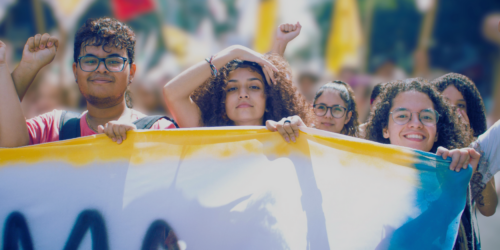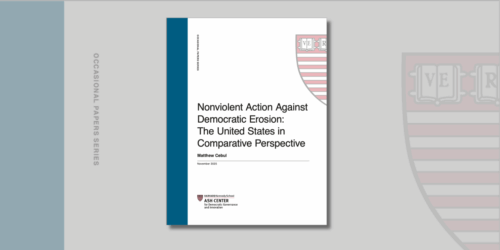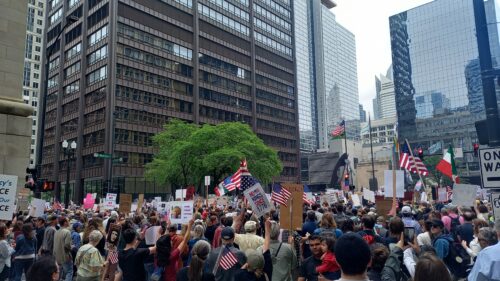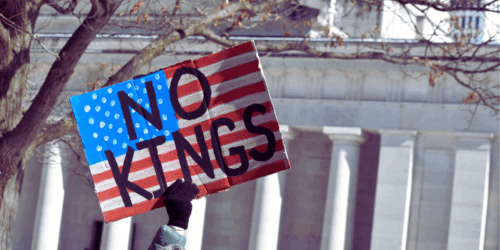
Policy Brief
Why Gen-Z Is Rising
Erica Chenoweth and Matthew Cebul analyze the global surge of Gen Z-led protest movements, showing how economic insecurity, exclusion from power, and corruption are driving youth mobilization worldwide.
Commentary
CCC logged more than 13,400 left-wing protests across more than 2,000 different U.S. cities and towns
The Crowd Counting Consortium recorded more than 13,400 left-wing protests, counter-protests, rallies, demonstrations, and direct actions in more than 2,000 different U.S. cities and towns in 2022, where “left-wing” includes everything from Democratic partisan rallies to demonstrations by communist, anti-fascist, or anarchist groups. This post summarizes a number of patterns and trends we observed in those events.
In 2022, the U.S. saw several waves of protests and rallies for reproductive rights against a backdrop of persistent activism against structural racism and police violence. Environmental concerns, LGBTQ+ rights, and gun reform also featured significantly in left-wing protest activity over the course of a year that brought worsening news about the climate crisis, a surge in anti-queer activism and terrorism from the right, and nearly 650 new mass shootings. The incidence of arrests, protester injuries, and property damage at left-wing protests all declined further from their 2020 peaks, while the count of armed left-wing protests increased slightly.
CCC makes and freely shares the data on which this analysis is based in hopes of supporting scholarship, journalism, and activism on these issues. For details on definitions and methods underlying these data, please see our coding guidelines. To access the data and documentation, please visit our GitHub repository. If you are a scholar, researcher, journalist, or activist who is interested in working with the data set and have questions about how to use it, please contact Jay Ulfelder at julfelder@hks.harvard.edu.
Counts
In 2022, CCC logged more than 13,400 left-wing protests across more than 2,000 different U.S. cities and towns. That’s a 7-percent increase over the roughly 12,500 left-wing protests we recorded across 1,878 cities and towns in 2021, and—consistent with long-standing patterns—more than twice the count of right-wing protests we saw in 2021 (about 5,700; for a discussion of trends in those, see this blogged report.)
We were able to find information on crowd sizes for about 39 percent of the left-wing events we recorded in 2022, up from 34 percent in 2021. At the roughly 5,200 events for which we had information about crowd size, we saw approximately 2.6 million participants, give or take a million. The mean crowd size at events with information on it was just under 500, while the median was 50, both up from 121 and 40, respectively, in 2021. New York City’s annual Pride March was by far the largest of those events, with “thousands” or “millions” of participants and observers, depending on which source you consult. (Since its inception in 2017, CCC has consistently regarded LGBTQ+ pride festivals and parades as inherently political and included them in its collection process, a status implicitly reaffirmed by the recent surge in right-wing mobilization against them.)
Arrests occurred at 170 left-wing events in 2022 (1.3 percent), down significantly from 284 in 2021 (2.3 percent) and far below the more than 1,000 events (5.6 percent) with arrests in 2020.
Protesters damaged property at 86 left-wing events in 2022 (0.6 percent), down from 105 (0.8 percent) in 2021 and 550 (2.9 percent) in 2020. Damage in 2022 ranged from graffiti and broken windows to arson.
Participants were reportedly injured at 45 left-wing events in 2022 (0.3 percent), down from 66 (0.5 percent) in 2021 and 379 (2.0 percent) in 2020.
Three participants died at left-wing events in 2022.
Participants evidently carried firearms at 46 of the left-wing events (3.3 percent) we recorded in 2022, up a handful from 42 (3.3 percent) in 2021. (We only began consistently tracking this information for all events we log in 2021, so we can’t provide comparable statistics for 2020.)
Themes
The bar chart below shows counts of protest events in 2022 at which participants’ demands were linked to the several dozen issues we routinely track with tags based on protester claims. Individual events can and often do raise any number of issues, so the sum of the counts shown in the chart is much larger than the annual count of events reported above.

Racism and policing have been two of the most common themes in left-wing protest activity since 2020, and that pattern persisted in 2022. Some of these protests occurred in response to new cases of police killing Black people, including (but not limited to) Amir Locke, James Williams, Jayland Walker, Patrick Lyoya, and Donnell Rochester. Hundreds of others were gatherings that recurred monthly, weekly, or even daily to keep boosting the Black Lives Matter movement’s calls for racial justice and police reform or abolition.
While racism remained the single most commonly raised issue in 2022, reproductive rights nearly displaced it, and leapfrogged over policing, due to several waves of action in response to the Supreme Court’s reversal of Roe v. Wade. As shown in the chart below, protests related to abortion rights spiked four different times in 2022:
For the period from the May 2 leak until Election Day on November 8, CCC recorded nearly 4,000 protests calling for abortion access across more than 1,200 U.S. cities and towns. By comparison, the George Floyd uprising of 2020—possibly the largest protest wave in U.S. history—involved nearly 9,700 protests across more than 3,050 cities and towns during the 10 weeks from late May until the end of July.

The judiciary and women’s rights rounded out the top five themes in 2022 because of their linkage to abortion access and reproductive rights.
The environment was the next-most common theme in left-leaning protests last year. The two busiest days on this topic in 2022 were March 25, when Greta Thunberg’s Fridays for Future called another global climate strike, and Earth Day, April 22. In some ways, though, the puzzle of left-wing activism of 2022 was that there weren’t even more environment-themed actions, given the increasingly evident urgency of the climate crisis. Even the busier of those two days last year, the March climate strike, barely saw more than 100 events across the U.S., far fewer than the hundreds associated with the Global Climate Strike of September 2019, and a September 2022 global strike called by Fridays for Future produced only about 30 actions in the U.S., according to our data.
LGBTQ+ rights also ranked among the top 10 issues raised at left-wing protests last year. In addition to new and longstanding annual pride parades and festivals, communities also mobilized in 2022 to push back against a wave of state legislative actions and right-wing protests and violence targeting the queer community.
Guns rounded out the top 10 issues raised by left-wing protesters in 2022. Led by March for Our Lives and Everytown for Gun Safety, crowds mobilized nationwide in the wake of mass shootings at a supermarket in Buffalo, New York, and an elementary school in Uvalde, Texas, to call for federal and state legislation tightening access to firearms. The attack on Club Q in Colorado Springs in November and the 10-year anniversary of the mass shooting at Sandy Hook Elementary also spurred waves of activism around gun violence. Education also landed in the top 10 themes for 2022 because of the references to school safety at protests following the Uvalde mass shooting and in the many Sandy Hook remembrance vigils.
Rhetoric
This past spring, CCC began using the ‘claims’ field in our data set to capture verbatim as many non-duplicate slogans and chants we see in photos and video and from, and prose about, each event as we can, along with coders’ summaries of protesters’ aims. The result is a rapidly growing corpus of protest rhetoric that helps us describe what protests were about in participants’ own words.
The centrality of abortion rights and Black Lives Matter activism to left-wing mobilization in 2022 is plain to see in a chart of the 20 phrases we saw or heard most often from protesters over the past year. A full 17 of the 20 phrases—including nine of the top 10—relate to reproductive rights or women’s rights. The phrase “Black Lives Matter” ranked fourth, and the “no justice no peace” refrain often heard at protests against racism and police violence cracked the top 20 as well. The only other theme with a phrase in the top 20 was gun reform, as “protect kids not guns” landed in the middle of the chart between “never again” (often seen on homemade posters at protests for abortion rights alongside an image of a wire hanger) and “keep your laws off my body”.

A word cloud of more than 6,800 distinct terms from all those verbatim phrases tells a similar story. More interesting here is the color and variety of the language used, especially across those thousands of protests for abortion rights. Lots of references to bodies and body parts (uterus, vagina, ovaries, cervix, pussy, womb), religion (church, rosaries, theocracy, Jesus), specific Supreme Court justices (especially Alito, Barrett, Thomas, Kavanaugh, and Roberts), a few Spanish words (aborto, libre), and—especially in the wave of events immediately following the June 24 SCOTUS ruling—a fair amount of cursewords (fuck, fucketh).

Armed Community Defense Groups
One notable trend evident in our data from 2022 was the growth in activity by armed leftist and anarchist groups, including but not limited to John Brown Gun Clubs (JBGCs) and chapters of the Socialist Rifle Association (SRA). We saw JBGCs at 29 protest or counter-protest events in 2022, up from 7 in 2021 and 5 in 2020; and we saw SRA chapters at 7 events in 2022, up from 2 in 2021 and none in 2020. Of the 29 events at which we saw JBGCs in 2022, 19 related to LGBTQ+ rights, and 11 were counter-protests. Notably, we also saw 14 different named JBGCs at those 29 events in 2022, up from three in 2021 (Puget Sound, Elm Fork, and Connecticut) and one in 2020 (Puget Sound).
Mainstream media coverage often lumps these groups together with right-wing militias an casts them as part of broader and problematic escalation of political violence, but that view obscures some crucial differences. Most importantly, these leftist groups construe themselves as agents of community defense rather than self-appointed enforcers of a particular political or legal order. They are, in the words of one prominent JBGC, “intolerant of injustice,” and they aim to help protect targeted groups against violent expressions of it. Rather than deputizing themselves as proactive peacemakers, as various right-wing militias did in the summer of 2020, these organizations generally only come when invited and included in security planning, and they typically adopt a protective posture rather than a confrontational one.
That’s not to say there are no parallels. Similar to many right-wing militias, even when operating under a common label, these community defense groups generally lack central governance. As a member of one JBGC put it, John Brown Gun Club is a decentralized brand rather than a formal organization or hierarchical network. Also like some right-wing militias, these groups routinely engage in a variety of other activities consistent with their missions, including firearm practice, first-aid training, and mutual-aid actions.
These armed leftist and anarchist groups are also part of a much larger and longer tradition of organizing for community and self-defense by marginalized groups who are faced with intimidation and terrorism, and who—with cause—see police as part of the problem rather than a solution. The Black Panthers are an obvious reference point from the American civil rights movement of the 1950s and 60s, when armed community defense arguably played a more important role in supporting the cause of racial justice than the conventional narrative acknowledges. John Brown Gun Clubs have been around for years, and their history is intertwined with an antifascist movement called Redneck Revolt that surged after Trump’s election in 2016. More recently, this movement has spawned efforts like We Are the Ones We’ve Been Waiting For’s Arm the Girls initiative, which aims to promote a culture of self-defense among BIPOC trans femmes. It has also birthed organizations like Sacramento’s Pride Was a Riot, who share an antifascist ethos with JBGCs while focusing their energy on support and defense of the local queer community.
Policy Brief
Erica Chenoweth and Matthew Cebul analyze the global surge of Gen Z-led protest movements, showing how economic insecurity, exclusion from power, and corruption are driving youth mobilization worldwide.
Occasional Paper
In this report, Matthew Cebul, Lead Research Fellow for the Nonviolent Action Lab, examines the effectiveness of nonviolent action movements in supporting democratic resilience globally. Identifying challenges faced by nonviolent pro-democracy movements, Cebul offers key takeaways for combating accelerating democratic erosion in the US and abroad.
Article
As organizers for No Kings 2 seek historic turnout on October 18, the broader pro-democracy movement has already broken new ground.
Policy Brief
Erica Chenoweth and Matthew Cebul analyze the global surge of Gen Z-led protest movements, showing how economic insecurity, exclusion from power, and corruption are driving youth mobilization worldwide.
Occasional Paper
In this report, Matthew Cebul, Lead Research Fellow for the Nonviolent Action Lab, examines the effectiveness of nonviolent action movements in supporting democratic resilience globally. Identifying challenges faced by nonviolent pro-democracy movements, Cebul offers key takeaways for combating accelerating democratic erosion in the US and abroad.
Article
In this op-ed, Liz McKenna examines the second ‘No Kings’ protest on October 18 and offers strategies for translating successful protest movements into influential policy change. She emphasizes the importance of sustained organizational efforts alongside protest activity to engage actors across partisan lines, building a broad coalition and a durable base for the movement.


